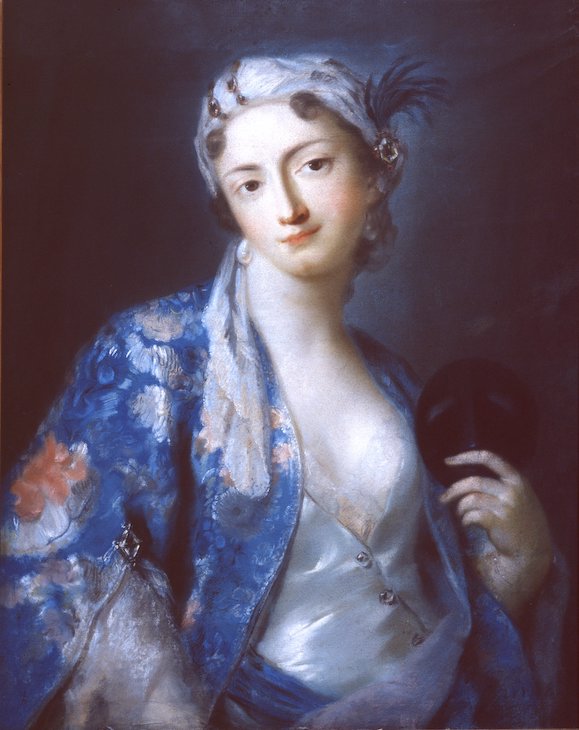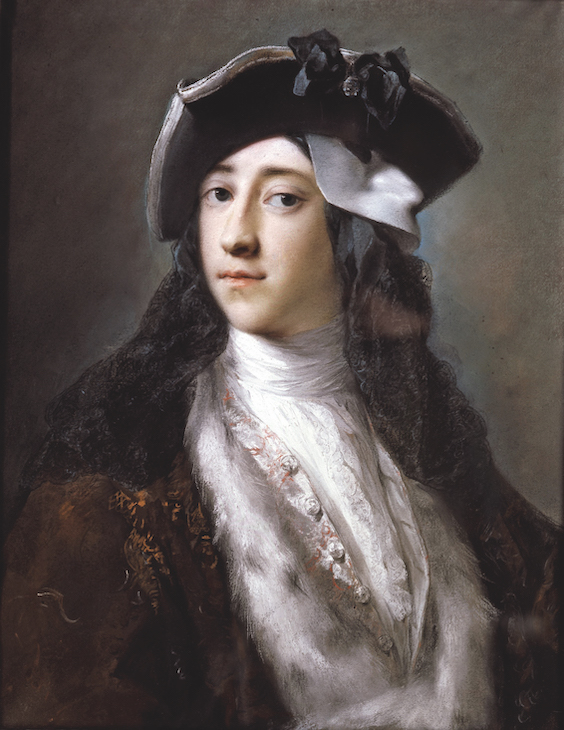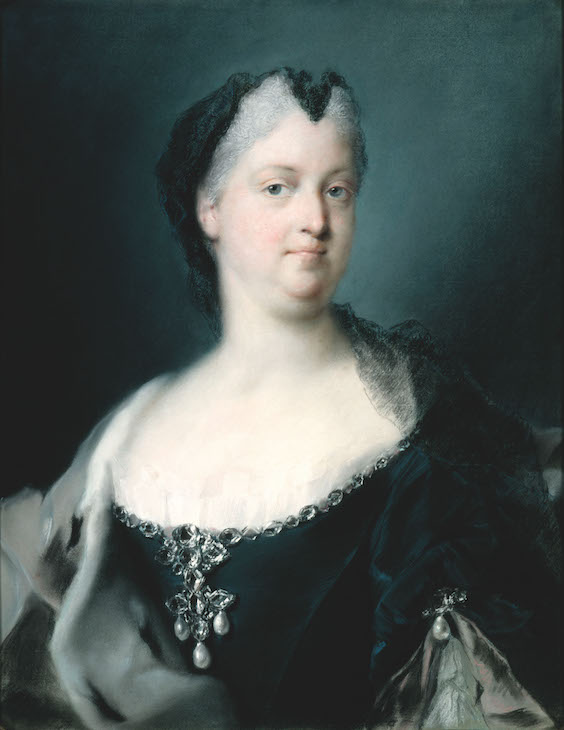Rosalba Carriera was an artist of European stature, whose fascinating work and career deserve fresh analysis, and so this book by Angela Oberer is to be warmly welcomed. Surprisingly it is the first substantial study of Carriera to be published in English, and while broadly it takes a chronological, biographical approach, it integrates key contextual themes: issues of patronage, iconography and the evolution of the medium that the artist brilliantly used and popularised – pastel. Her letters, diary and finances are all discussed, as is a study of her home as a creative and domestic space, to create a compelling and intimate portrait of Carriera and her ability to navigate with success the male-dominated art world of the 18th century.
 Born in Venice, Carriera started her career as a miniature painter. She explored allegorical and genre subjects, as well as occasional portraiture, anticipating thematically the later works for which she is chiefly renowned. Oberer deftly connects these little-known paintings with sources from Venetian Renaissance art, especially Veronese, and explores their intermittent erotic undercurrents, which did not seem to prompt any contemporary comment.
Born in Venice, Carriera started her career as a miniature painter. She explored allegorical and genre subjects, as well as occasional portraiture, anticipating thematically the later works for which she is chiefly renowned. Oberer deftly connects these little-known paintings with sources from Venetian Renaissance art, especially Veronese, and explores their intermittent erotic undercurrents, which did not seem to prompt any contemporary comment.
Formal professional recognition for Carriera’s skills came in 1705 when she was elected a member of the Accademia di San Luca in Rome; this important development was aided by her support from Christian Cole, a diplomat who later became secretary to the British Ambassador in Venice. However, Cole was more than just an enthusiast for the artist’s work, as he sent her many gifts and saw himself as a suitor; she ultimately rejected him, retaining her independence.
The book then moves on to Carriera’s life-changing discovery of pastel painting. She is shown to have been fascinated by the medium’s technical and expressive possibilities and to have rapidly experimented with it, excelling at its use – notably for portraiture. The artist worked with great success for the international travellers who arrived in Venice seeking diversions and the acquisition of art. It was throughout this period that her reputation gradually became a pan-European one and owning one of her works a fashionable compulsion. The relatively small scale of her pastels meant they were easily taken home or shipped across the continent. Oberer plots the gradually increasing prices her works commanded, and the occasional role she played as a consultant advising on paintings by other artists that collectors were seeking to acquire, as well as working as a restorer. Carriera’s British, French and German clientele are all analysed in depth. She describes herself in a letter to the French painter Nicolas Vleughels as having been ‘attacked’ by the English – in other words bombarded with requests for work – and therefore having little time for other commissions.

Portrait of Felicità Sartori (1740–41), Rosalba Carriera. Galleria degli Uffizi, Florence
Her renown was further enhanced by a highly successful stay in Paris in 1720–21. This visit, which was undertaken with her mother and sisters, was prompted by an invitation from the patron and financier Pierre Crozat, in whose hôtel on the Rue de Richelieu the family stayed. She became the toast of the city’s artistic community, was admitted to the Académie Royale de Peinture et Sculpture, and is widely credited with enhancing the status and popularity of pastel portraiture in France.
Oberer next explores Carriera’s status back in Italy as a professional, unmarried woman of great fame, and as an artist who promoted herself as a ‘curiosity’ of Venice, living in a palazzo on the Grand Canal. She was aware of her value as a cultural celebrity (to use an anachronistic phrase), and numerous portraits of wealthy tourists and repeated allegorical sets of pastels, on themes such as the seasons, further increased the esteem her work inspired. Contemporary commentators repeatedly referred to her ingenuity at securing a likeness and the ‘grace’ and ‘lightness’ of her creations, as well as the beauty of her achievement as a colourist. It is striking that her critical fortunes among modern commentators have not always been so generous.

Portrait of Gustavus Hamilton, 2nd Viscount Boyne (c. 1730–31), Rosalba Carriera. Barber Institute of Fine Arts, Birmingham
In 1723 Carriera visited Modena, where she made portraits of the daughters of Rinaldo III d’Este, and then in 1730 she undertook her last journey abroad, to the Habsburg court of Charles VI in Vienna. It seems that she enjoyed the splendour and luxury of this environment; among various commissions she produced an especially impressive pastel of Empress Wilhelmine Amalie.
At home in Venice, declining eyesight eventually led to blindness in 1751; she lived on for a further six years, and was buried in a church that was demolished in the 19th century, so no tomb or memorial survives. Oberer does not, however, end her account on this poignant note, but provides a fascinating coda, exploring the social life Carriera had enjoyed at home, where she appears to have hosted informal salons to which clients, friends and the curious were drawn. Such discourse enhanced her reputation further, as did her riveting self-portraits which range across her career and are closely analysed at the end of the book. Thoughtful discussion is especially focused on the examples in Florence, Windsor and Dresden, which are great technical achievements and exercises in candour, but also contributed in intriguing ways to the self-promotion at which she was so adept.

Portrait of Empress Wilhelmine Amalie (1730), Rosalba Carriera. Gemäldegalerie Alte Meister, Dresden
This new study admirably sets out to bring Carriera’s achievement to a wider audience, and makes a significant contribution to the study of women artists of the 18th century in the context of society’s gendered expectations. It reveals how, uniquely at the time, Carriera developed highly successful strategies for challenging such assumptions. What works against these ambitions is the fact that there are only eight colour plates in the book, so the qualities of the artist’s technical skills and character studies are not extensively conveyed by the publisher; moreover, the cost is surely prohibitive for many who might want to learn more about this remarkable figure, who has been little known beyond the realm of pastel enthusiasts for far too long.
The Life and Work of Rosalba Carriera (1673–1757): The Queen of Pastel by Angela Oberer is published byAmsterdam University Press.
From the October 2020 issue of Apollo: preview and subscribe here














![Masterpiece [Re]discovery 2022. Photo: Ben Fisher Photography, courtesy of Masterpiece London](http://zephr.apollo-magazine.com/wp-content/uploads/2022/07/MPL2022_4263.jpg)
‘Like landscape, his objects seem to breathe’: Gordon Baldwin (1932–2025)